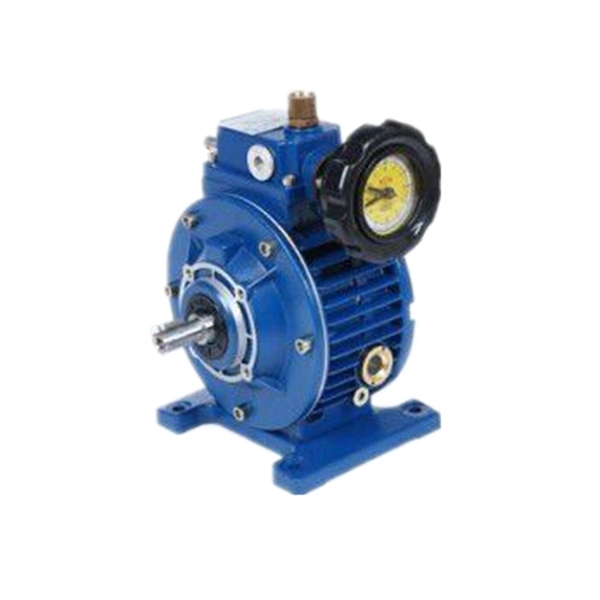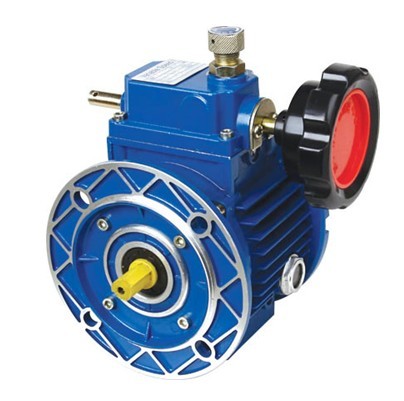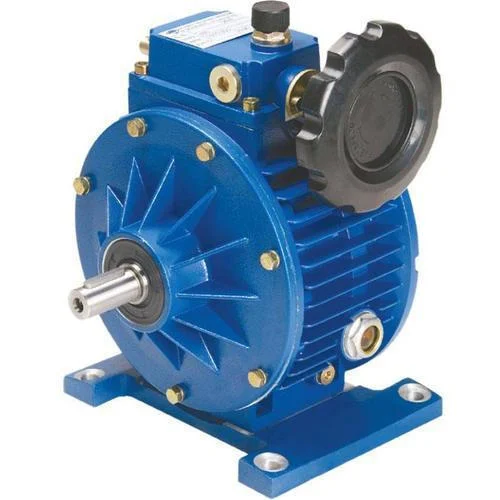Product Description
MB Udl VAR TXF S-TXF Series Stepless Motovariator Variator Gear Unit Box Speed Reducer Gearbox
Features
1. High precision: 0.5-1
2. Wide speed range, the output speed ratio can be in 1/1.4 between 1/7
3. High intensity and long service life
4. Easy speed regulation
5. Continuous work, smooth operation, stable performance, and low noise
6. Whole sealing and low requirement for the environment
7. Compact organization and small size.
8. It is made of high-quality aluminum alloy with a beautiful appearance, is lightweight, and no rusting.
9. Good adaptability. UDL series are continuously variable transmissions that can combine with variable reducer units to realize low-speed continuous variable speed.
Application areas: It can be widely used in food, packaging, chemical, pharmaceutical, plastic, papermaking, machine tools, transportation, and various kinds of automatic production lines and transmission lines that need to adjust speed.
Product Photos
Product Description
| Models | Power | Ratio | O. Speed | O.Torque | O. Shaft Dia. | O. Flange Dia. |
| UDL002 | 0.18KW | 1.6~8.2 | 800~170rpm | 1.5~3N.m | Φ11 | Φ140 |
| UDL005 | 0.25KW | 1.4~7 | 1000~200rpm | 2.2~6N.m | Φ14 | Φ160 |
| UDL005 | 0.37KW | 1.4~7 | 1000~200rpm | 3~6N.m | Φ14 | Φ160 |
| UDL571 | 0.55KW | 1.4~7 | 1000~200rpm | 4~8N.m | Φ19 | Φ200 |
| UDL571 | 0.75KW | 1.4~7 | 1000~200rpm | 6~12N.m | Φ19 | Φ200 |
| UD571 | 1.1KW | 1.4~7 | 1000~200rpm | 9~18N.m | Φ24 | Φ200 |
| UD571 | 1.5KW | 1.4~7 | 1000~200rpm | 12~24N.m | Φ24 | Φ200 |
| UD030 | 2.2KW | 1.4~7 | 1000~200rpm | 18~36N.m | Φ28 | Φ250 |
| UD030 | 3.0KW | 1.4~7 | 1000~200rpm | 24~48N.m | Φ28 | Φ250 |
| UD030 | 4.0KW | 1.4~7 | 1000~200rpm | 32~64N.m | Φ28 | Φ250 |
| UD050 | 5.5KW | 1.4~7 | 1000~200rpm | 45~90N.m | Φ38 | Φ300 |
| UD050 | 7.5KW | 1.4~7 | 1000~200rpm | 59~118N.m | Φ38 | Φ300 |
FAQ
Q: Can you make the variator gearbox with customization?
A: Yes, we can customize as promised, like color, shaft, material, etc.
Q: Do you provide samples?
A: Yes. The sample is available for testing.
Q: What’s your lead time?
A: Standard products need 5-30 days, a bit longer for customized products.
Q: Do you provide technology support?
A: Yes. Our company has a design and development team, we can provide technology support if you
need.
Q: How do you ship to us?
A: It is available by air, sea, or train.
Q: How to pay the money?
A: T/T and L/C are preferred, with a different currency, including USD, EUR, RMB, etc.
Q: How can I know if the product is suitable for me?
A: >1ST confirm drawing and specification >2nd test sample >3rd start mass production.
Q: Can I come to your company to visit?
A: Yes, you are welcome to visit us at any time.
Q: How shall we contact you?
A: You can send an inquiry directly, and we will respond within 24 hours. /* January 22, 2571 19:08:37 */!function(){function s(e,r){var a,o={};try{e&&e.split(“,”).forEach(function(e,t){e&&(a=e.match(/(.*?):(.*)$/))&&1
| Application: | Motor, Machinery, Gearbox |
|---|---|
| Hardness: | Hardened Tooth Surface |
| Installation: | Horizontal Type |
| Samples: |
US$ 100/Piece
1 Piece(Min.Order) | Order Sample Blue or grey
|
|---|
| Customization: |
Available
| Customized Request |
|---|
.shipping-cost-tm .tm-status-off{background: none;padding:0;color: #1470cc}
|
Shipping Cost:
Estimated freight per unit. |
about shipping cost and estimated delivery time. |
|---|
| Payment Method: |
|
|---|---|
|
Initial Payment Full Payment |
| Currency: | US$ |
|---|
| Return&refunds: | You can apply for a refund up to 30 days after receipt of the products. |
|---|

What maintenance practices are crucial for prolonging the lifespan of variator gearboxes?
Proper maintenance practices are essential for prolonging the lifespan of variator gearboxes and ensuring their optimal performance. By following these crucial maintenance practices, you can maximize the longevity of variator gearboxes:
- Regular Inspections: Conduct regular inspections of the variator gearbox to identify any signs of wear, damage, or abnormal conditions. Inspect the gearbox for leaks, unusual noises, vibrations, and any visible signs of damage or misalignment. Regular inspections help in detecting potential issues early on, allowing for timely maintenance and preventing further damage.
- Proper Lubrication: Ensure proper lubrication of the variator gearbox components. Lubricants reduce friction, wear, and heat generation, thereby extending the lifespan of the gearbox. Follow the manufacturer’s recommendations for lubricant type, quantity, and change intervals. Regularly check the lubricant levels and top-up or replace the lubricant as needed. Proper lubrication is crucial for smooth operation and preventing premature failures.
- Cleaning: Keep the variator gearbox clean and free from dirt, dust, and debris. Regularly clean the exterior of the gearbox using appropriate cleaning methods and materials. Avoid introducing contaminants into the gearbox during cleaning or maintenance procedures. Cleanliness helps in preventing abrasive particles from entering the gearbox and causing damage to the internal components.
- Torque and Tension Checks: Periodically check the torque and tension of fasteners, belts, or chains associated with the variator gearbox. Ensure that they are properly tightened and tensioned according to the manufacturer’s specifications. Loose fasteners or improper belt/chain tension can lead to excessive vibrations, misalignment, and premature wear of gearbox components.
- Alignment: Verify the alignment of the variator gearbox with the connected equipment or shafts. Misalignment can cause increased stress on the gearbox components, leading to accelerated wear and reduced lifespan. Use appropriate alignment tools and techniques to ensure proper alignment, minimizing excessive loads and improving the longevity of the gearbox.
- Temperature Monitoring: Monitor the temperature of the variator gearbox during operation. Excessive heat can indicate issues such as inadequate lubrication, overloading, or improper ventilation. Regularly check the temperature using temperature sensors or thermal imaging techniques. Address any temperature abnormalities promptly to prevent potential damage to the gearbox.
- Condition Monitoring: Implement condition monitoring techniques to assess the health of the variator gearbox. This can include vibration analysis, oil analysis, or other predictive maintenance methods. By monitoring key parameters, such as vibration levels or oil characteristics, potential issues can be detected early, and appropriate maintenance actions can be taken to prevent major failures.
- Training and Documentation: Ensure that maintenance personnel receive proper training on variator gearbox maintenance practices. Familiarize them with the specific procedures, safety guidelines, and recommended maintenance intervals provided by the gearbox manufacturer. Maintain detailed documentation of maintenance activities, including inspections, lubricant changes, repairs, and any abnormalities observed. This documentation helps in tracking maintenance history and identifying recurring issues.
- Manufacturer Guidelines: Always follow the maintenance guidelines provided by the variator gearbox manufacturer. These guidelines may include specific maintenance intervals, recommended spare parts, and detailed instructions for various maintenance tasks. Adhering to the manufacturer’s guidelines ensures that maintenance practices align with the gearbox’s design and specifications.
By implementing these crucial maintenance practices, you can significantly prolong the lifespan of variator gearboxes, minimize downtime, and optimize their performance throughout their operational life.

Can variator gearboxes be customized for specific speed and torque ranges?
Yes, variator gearboxes can be customized to meet specific speed and torque requirements in various applications. Manufacturers offer the flexibility to design and configure variator gearboxes according to the specific needs of customers. Here’s how variator gearboxes can be customized for specific speed and torque ranges:
Variable Pulley Design:
The design of the variable pulley system in a variator gearbox can be customized to achieve desired speed and torque ranges. The shape, size, and configuration of the pulleys can be adjusted to provide different gear ratios and accommodate specific application requirements. By modifying the pulley’s dimensions and angles, variator gearboxes can achieve a wide range of speed ratios and corresponding torque outputs, allowing customization for specific speed and torque ranges.
Selection of Components:
Manufacturers can select and optimize various components within the variator gearbox to match specific speed and torque ranges. This includes the choice of materials for gears, bearings, and other critical components. By selecting appropriate materials, manufacturers can ensure that the variator gearbox can handle the required torque levels without compromising its durability and performance.
Torque-Sensing and Control Systems:
The torque-sensing and control systems within variator gearboxes can be customized to provide precise control over speed and torque. Manufacturers can incorporate sensors and control algorithms that are tailored to the specific speed and torque requirements of an application. These systems monitor the torque load and adjust the gear ratio accordingly to maintain the desired speed and torque output, allowing for customization within specific ranges.
Applications in Parallel or Series:
In some cases, multiple variator gearboxes can be configured in parallel or series to achieve the desired speed and torque ranges. By combining the outputs of multiple variator gearboxes, either in parallel or series arrangement, the overall speed and torque capabilities can be customized to meet specific application requirements. This configuration allows for scalability and adaptability to different speed and torque demands.
Computer-Aided Design (CAD) and Simulation:
Manufacturers utilize computer-aided design (CAD) software and simulations to customize variator gearboxes for specific speed and torque ranges. CAD tools enable the design and optimization of components, ensuring they can withstand the required torque levels and operate within the desired speed ranges. Simulations help manufacturers evaluate the performance of the customized variator gearbox under different operating conditions, allowing for fine-tuning and optimization.
Collaboration with Customers:
Manufacturers work closely with customers to understand their specific speed and torque requirements. By collaborating with customers, manufacturers can gather detailed information about the application’s operational parameters, load profiles, and performance expectations. This collaborative approach ensures that the variator gearbox is customized to precisely match the speed and torque ranges needed for the application.
Through variable pulley design, component selection, torque-sensing and control systems, parallel or series configurations, CAD and simulation tools, and collaboration with customers, variator gearboxes can be customized to deliver specific speed and torque ranges. This customization capability allows variator gearboxes to be tailored to a wide range of industrial applications, ensuring optimal performance and efficiency.

What is a variator gearbox and how does it work in mechanical systems?
A variator gearbox, also known as a variable speed transmission, is a type of gearbox that allows for continuous and stepless variation of the output speed within a certain range. It is commonly used in mechanical systems where the output speed needs to be adjusted dynamically without fixed gear ratios. The variator gearbox achieves this by employing specific mechanisms such as belts, chains, or cones.
One common type of variator gearbox is the belt-and-pulley system. It consists of two variable-diameter pulleys connected by a belt. These pulleys can change their effective diameter by adjusting their position. The input pulley is connected to the power source, such as an engine or motor, while the output pulley is connected to the load. By varying the diameters of the pulleys, the speed ratio between the input and output can be continuously adjusted, allowing for a wide range of output speeds.
The variator gearbox works based on the principle of changing the effective radius of the pulleys. When the input pulley diameter increases or the output pulley diameter decreases, the belt is forced to ride higher on the pulley, resulting in a larger effective radius. This causes the output speed to decrease relative to the input speed. Conversely, when the input pulley diameter decreases or the output pulley diameter increases, the belt rides lower on the pulley, leading to a smaller effective radius and an increase in the output speed.
The variator gearbox can be controlled manually or automatically, depending on the application. In manual systems, the adjustment of the pulley diameters is done by the operator using mechanical or hydraulic mechanisms. In automatic systems, the adjustment is typically controlled by a computer or an electronic control unit (ECU) based on various parameters such as speed, load, or user inputs.
One of the key advantages of variator gearboxes is the ability to achieve smooth and stepless speed variation. Unlike traditional gearboxes with fixed gear ratios, variator gearboxes offer infinite possibilities for adjusting the output speed. This flexibility is particularly beneficial in applications where precise control of speed is required, such as in vehicles, industrial machinery, and power transmission systems.
However, it’s important to note that variator gearboxes may have limitations in terms of torque capacity and efficiency compared to traditional fixed-ratio gearboxes. The power transmission efficiency of variator gearboxes can vary depending on the specific design and operating conditions.
In summary, a variator gearbox is a type of gearbox that allows for continuous and stepless variation of the output speed. It uses mechanisms such as belts, chains, or cones to adjust the effective diameter of the pulleys, enabling dynamic speed control in mechanical systems.


editor by CX 2024-04-29
